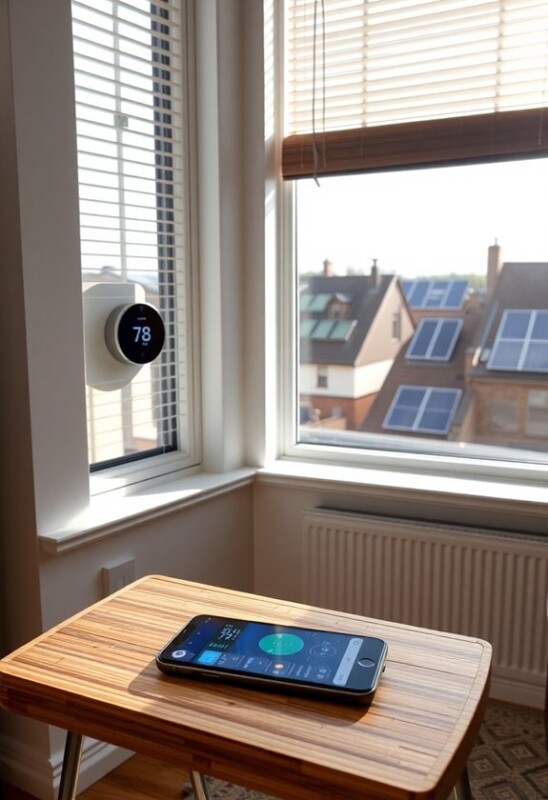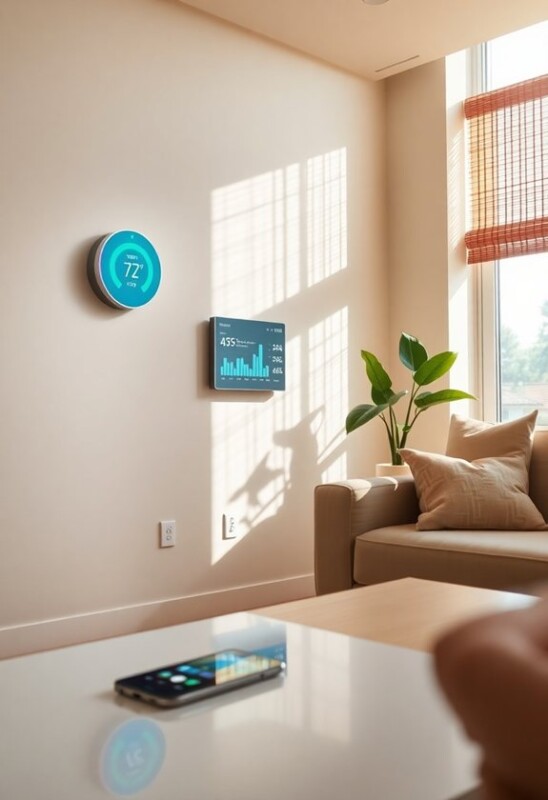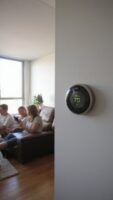Smart home systems reduce your environmental impact through multiple automated efficiencies. You’ll save up to 75% on lighting with LED integration, while smart thermostats tackle 19% of heating-related emissions. IoT sensors and AI analytics cut energy waste by 20%, and intelligent water systems prevent leaks while reducing outdoor water usage by 50%. When combined with renewable energy integration and waste tracking, these technologies create a thorough eco-solution that enhances your sustainability potential.
Key Takeaways
- Smart devices optimize energy consumption through real-time monitoring and AI-driven adjustments, reducing overall household energy waste by up to 20%.
- LED lighting systems and smart thermostats dramatically decrease energy usage while automatically adapting to occupancy and natural light conditions.
- Intelligent water management systems prevent waste through automated leak detection and smart irrigation, cutting water consumption by up to 50%.
- Integration with renewable energy sources enables optimal switching between solar, battery, and grid power based on real-time needs.
- Automated waste sorting and resource tracking systems help minimize environmental impact through proper recycling and reduced material waste.
The Real Environmental Impact of Smart Home Technology

While smart home technology promises significant environmental benefits, understanding its real-world impact requires examining both the advantages and challenges of implementation.
You’ll find significant reductions in energy consumption through LED lighting, which cuts usage by 75% compared to traditional bulbs, and smart thermostats that tackle the 19% of greenhouse gas emissions from heating.
However, your carbon footprint calculations must account for the energy required to power sensors, cameras, and wireless devices.
The key lies in strategic implementation: choosing interoperable systems, ensuring proper installation, and balancing the environmental cost of manufacturing against long-term energy savings.
Data-Driven Energy Optimization Systems
As smart homes evolve beyond basic automation, data-driven energy optimization systems now form the backbone of sustainable building management.
These systems utilize IoT sensors and AI-powered predictive analytics to monitor your energy consumption in real-time, reducing waste by up to 20%.
You’ll find smart HVAC controls automatically adjusting to occupancy patterns while automated lighting responds to natural daylight conditions.
The system’s AI algorithms analyze your usage data to identify inefficiencies and shift loads to off-peak hours.
Through digital twin technology, you can simulate different scenarios to enhance efficiency, while blockchain guarantees secure data transactions in your home’s energy management network.
Water Management Through Intelligent Automation
Intelligent water management systems have revolutionized how homeowners monitor and control their water consumption through advanced automation and IoT integration.
You’ll greatly reduce waste with automated leak detection that identifies even microscopic drips and triggers immediate shutoffs. The system’s FloSense Technology conducts daily tests, sending real-time alerts to your devices when issues arise.
Smart automated irrigation responds to weather and soil conditions, cutting outdoor water use by up to 50%.
You’re also protected from freeze damage through proactive alerts and automatic valve control.
With fixture-specific tracking and detailed analytics, you’ll gain unprecedented visibility into your water usage patterns, enabling data-driven conservation decisions.
Waste Reduction and Smart Resource Tracking
Through thorough monitoring and automated resource management, smart home systems deliver substantial waste reduction across multiple consumption streams.
You’ll find waste tracking capabilities in smart bins that automatically sort recyclables and compact refuse, while intelligent fridges monitor food expiration to prevent spoilage.
Resource optimization extends to predictive analytics that learn your household patterns, enabling systems to adjust energy and water usage precisely to your needs.
Smart home technology’s closed-loop approach supports sustainability through manufacturer take-back programs and responsible e-waste disposal.
These systems provide actionable data on your consumption patterns, helping you make informed decisions that minimize waste and enhance efficiency.
Renewable Integration and Grid Independence
Modern smart homes advance beyond waste management into renewable energy autonomy, offering extensive solutions for sustainable power generation and storage.
Solar panel integration with smart meters enables real-time tracking of your energy production, while advanced storage solutions capture excess power for later use.
Your path to grid independence includes:
- Automated switching between solar, battery, and grid power based on real-time needs
- Smart energy storage systems that enhance power usage during peak rate periods
- Intelligent forecasting that adjusts consumption patterns based on weather predictions and historical data
These integrated systems optimize your renewable energy investment while reducing reliance on traditional power grids.
Sustainable Materials and Long-Term Maintenance
As smart homes evolve, sustainable materials and proactive maintenance strategies have become essential pillars of eco-friendly home automation.
You’ll find sustainable design principles reflected in the use of bamboo, recycled steel, and bioplastics, which greatly reduce environmental impact.
Smart devices now incorporate eco-friendly components like biodegradable polymers and reclaimed electronics, while modular designs enable easy repairs and updates.
Long-lasting materials combined with regular firmware updates extend system longevity without requiring physical replacements.
Closed-loop recycling systems and manufacturer take-back programs guarantee your smart home components return to the production cycle, minimizing waste and resource depletion.
Conclusion
True smart home eco-friendliness depends on your holistic approach to implementation. You’ll achieve the greatest environmental impact by combining automated energy management, water conservation systems, and waste reduction technologies with renewable energy integration. By selecting sustainably manufactured devices and maintaining them properly, you’re creating a system that doesn’t just save resources today but continues to optimize your home’s environmental footprint for years to come.



